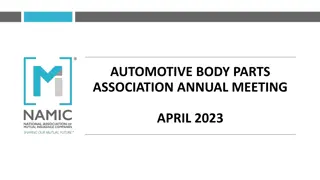Accelerating Auto Sales and Industry Trends
Auto sales are rapidly accelerating in 2021 despite challenges like a microchip shortage affecting production. Q1 2021 saw a strong increase in sales, with a shift in buyer considerations towards factors like durability, comfort, and technology. Dealerships are adapting to changing trends, increasing profitability, and adjusting advertising expenditures to attract buyers in a competitive market. Light-duty trucks remain popular in the market.
Uploaded on Oct 01, 2024 | 0 Views
Download Presentation

Please find below an Image/Link to download the presentation.
The content on the website is provided AS IS for your information and personal use only. It may not be sold, licensed, or shared on other websites without obtaining consent from the author. Download presentation by click this link. If you encounter any issues during the download, it is possible that the publisher has removed the file from their server.
E N D
Presentation Transcript
Auto Sales Are Accelerating Rapidly Although the total 2020 new light-vehicle units sold were approximately 14.5 million, the fewest since 2012, Q1 2021 sales increased 11.8% YOY and March s SAAR (seasonally adjusted annual rate) was approximately 18.0 million and April s was 18.5 million. Because so many automakers only report unit sales quarterly, it will be July before the complete Q2 2021 performance is known, but the estimated 1.36 million new light vehicles sold during April is almost a 90% YOY increase. According to Cox Automotive, durability/reliability, driving comfort, reputation, interior layout, technology and ruggedness were the most important buyer consideration factors during Q1 2021, with affordability and fuel efficiency declining factors.
Chip and Inventory Challenges Are Stalling Sales The auto industry now faces an extreme good news/bad news scenario, as consumers have plenty of saved money and credit availability, but a microchip shortage has resulted in some automakers stopping production. The chip storage has only become worse during early 2021, as AlixPartners estimate for 2021 auto industry revenue loss almost doubled from January ($61 billion) to April ($110 billion). This would result in 3.9 million fewer vehicles produced globally. The significant increase in April 2021 sales also added to the challenge, especially since May is historically a peak sales month. The total US inventory was 2.24 million at the end of April, a 37% YOY decrease, and the 44 days of supply was 75% less than April 2020.
Dealership Business Trends The average US dealership generating a record $2.1 million in pretax profits for 2020, because of a combination of unusual factors, including reducing expenses; more online buying, which increased sales productivity; and lower floorplan interest rates. March 2021 data from the National Automobile Dealers Association (NADA) revealed pretax profits increased 197.2% YOY and total sales increased 28.1%; however, total operating profit decreased 482.6% YOY. The substantial improvement in March sales resulted in a 32.3% YOY increase for the new-vehicle department, as the selling price increased 6.5%, and a 31.9% increase for used vehicles, with an increase of 11.0%.
Dealership Advertising Expenditures Rebounding Although not quite as bad as some retail sectors, total 2020 dealership advertising expenditures decreased 19.1% from 2019 s $9.25 billion to 2020 s $7.48 billion, which also reduced the amount per new unit sold, or $640 and $582, respectively. Although still in red numbers, March 2021 advertising expenditures were much better: average of all dealerships -5.9%, domestic -2.7%, import -8.0%, luxury - 18.3% and mass -4.2%; however, with less inventory, many dealers can sell vehicles as soon as they arrive. According to The Media Audit s 62-Market 2020 Aggregate Survey, large percentages of adults, by age, said they planned to buy or lease a new car, van, truck, SUV or crossover: adults 18 34 33.6%, adults 35 49 36.0% and adults 50+ 30.4%.
Light-Duty Trucks Continue to Dominate The NADA reports total 2020-unit sales of light-duty trucks were 11,055,157 or a 10.2% decrease from 2019; however, the light-duty-truck segment s share of total light-duty vehicles sold increased from 2019 s 72.0% to 2020 s 76.4%. During April 2021, total light-duty truck sales at the average US dealership increased 34.2% YOY, compared to 11.1% for all of 2020. Domestic light- duty trucks increased 30.8% and import light-duty trucks increased 47.2%. Cox Automotive reported buyers consideration of a pickup truck has been declining from Q2 2020 s 35% to Q1 2021 s 29%. Consideration for the Ford F-150 decreased 16% from Q4 2020 and the Chevrolet Silverado 1500 decreased 13%.
Service Departments Evolve in Changing Market With more vehicle owners delaying service during 2020, it s understandable total service and parts sales for all US dealerships decreased 7.9% to $111.22 billion, which similarly reduced those sales at the average dealership by 7.6% to $6.69 million. Total 2020 body shop sales at US dealerships decreased even more, or -12.1% from 2019, probably because some body shop work wasn t as important to consumers; however, sales per repair order only decreased 1.5% to $719.64. Fixed-ops (service, parts and body shop) sales improved during March 2021, increasing 2.4% to $1.89 million at the average dealership. Sales at the average luxury dealership increased the most (9.1%), with import (+4.3%), mass (+0.8%) and domestic (+0.3%).
The Battle of Brands and Models The J.D. Power 2021 U.S. Vehicle Dependability StudySM is goods for automakers, dealers and consumers as the PP100 (number of problems per 100 vehicles) score for three-year-old vehicles, was the lowest ever, decreasing by 10% from the previous study. In the compact-car category, the Volkswagen Beetle was first; mid-size car, Kia Optima; large car, Toyota Avalon; compact premium car, Lexus ES, small premium car, BMW 2 Series; midsize premium car, Genesis G80; and midsize sporty car, Chevrolet Camaro. The Buick Envision was the highest-ranked compact SUV model; Kia Sportage, small SUV; Kia Sorento, midsize SUV; Chevrolet Tahoe, large SUV; Porsche Macan compact premium SUV; Mercedes-Benz GLA small premium SUV; and Lexus GX midsize premium SUV.
Consumer Perspectives According to a late-April 2021 Cox Automotive survey, 76% of active vehicle consumers were not only aware of the global microchip shortage, but also almost as many (73%) expected to pay more because the shortage is depleting inventories. The good news for the industry is 63% of the surveyed consumers were planning to postpone a purchase and 81% were still focused on their preferred vehicle segment. Of the 37% planning to postpone their purchase, more than 60% would wait 3 to 12 months. In Deloitte s September/October 2020 six-country survey, 74% of US consumers said they preferred their next vehicle to be gasoline- or diesel-powered, 16% a hybrid electric (HEV), 5% battery electric vehicle (BEV) and 5% other.
Car Buyers Media Habits Based on data from The Media Audit s 62-Market 2020 Aggregate Survey, it is unsurprising dealerships are spending 60% of their ad budgets on the Internet, as 97.7% of adults 18+ who plan to buy or lease any type of new vehicle were exposed to the Internet daily. Outdoor (95.3% daily exposure) and TV (94.4% daily exposure) were a close second and third. Social media was fourth at 93.5%, followed by direct mail 86.5%, radio 84.9% and newspaper 68.6%. Video streaming was very popular during 2020. The Media Audit survey found 87.3% of adults who plan to buy or lease any type of new vehicle watched video streaming during the past 7 days, with Netflix first at 64.4%, Amazon Prime 49.8% and Hulu 42.3%.
Electric Vehicles Are Waiting in the Wings Although electric vehicle (EV) sales have yet to increase significantly, technological advancements, especially driving range and charging time, will soon reduce the price of an EV to less than an internal combustion engine (ICE) vehicle. According to the J.D Power 2021 U.S. Electric Vehicle Consideration StudySM, 59% of those surveyed said they were somewhat likely to consider a BEV (battery EV) for their next purchase or lease and 46% who have owned a BEV were very likely to choose one again. Much work remains, as only 15% of current mass- market vehicle owners were very likely to consider a BEV as their next vehicle purchase. A lack of information about BEVs was the primary reason 30% of respondents were not yet considering a BEV.
The Car as an Audio Device According to Edison Research/Triton Digital s The Infinite Dial 2021 survey (January), 83% of adults 18+ said they drove or rode in a vehicle during the past month, compared to 87% in the January 2020 survey, indicating less travel as the pandemic wanes. This was likely why the audio sources adults were using in a vehicle were mostly unchanged from 2020, but AM/FM radio was still first at 81%. Owned digital music was still at 48% and online audio was still 33%; however, CD player decreased to 35% from 41%. More of those who had driven/rode in a vehicle during the past month had an in-dash information/entertainment system, or 20%, compared to 18% for 2020, and listening to audio via a cell phone increased another five percentage points to 50% of persons 12+.
Roadside Attractions Despite dealership inventory challenges, Cox Automotive s April 2021 Dealertrack Auto Credit Availability Index for all loans increased 0.4% to 98.4, indicating more auto credit was available; however, the index for all new vehicle loans decreased 3.4% YOY. Fleet sales suffered the most during 2020. Now, as sales rebound, they increased 106% YOY during April 2021, or 148,118 units. Nonetheless, 2021 YTD fleet sales are still 16% less than the January April 2020 period and 31% less than the same 2019 period. According to the Deloitte survey previously cited, US auto buyers still prefer to purchase their next vehicle in-person (71%), with 17% completely virtual and 12% partially virtual.
Advertising Strategies Although the microchip and inventory shortages are causing difficulties for car dealerships, maintaining a local advertising presence is essential to sustaining brand awareness for when inventory levels return to normal, and more consumers will be ready to buy. Dedicate a portion of ad dollars and messages to keep customers informed of the microchip shortage as they are generally aware of the situation. Provide updates and report how inventory is increasing. TV advertising is essential to creating brand and dealership loyalty and is where dealerships can reach the largest audience to direct them to a dealership s Website and online browsing/purchasing process. Promote its ease of use and convenience.
New Media Strategies Dealerships may want to follow the lead of Van Horn Automotive Group in Wisconsin. It began using a text- message management service, so employees could solicit customer reviews. It has generated thousands of mostly positive reviews to add to its Website. Another dealership, Rydell Auto Center, in North Dakota, initiated a live chat option on its online inventory pages, so customers can engage with an employee within minutes to answer questions. The system works better than a lead form. Beyer Auto Group in Virginia discovered simply calling previous service customers who hadn t had their vehicle serviced recently not only generated more service business, but also customers who appreciated the call.























